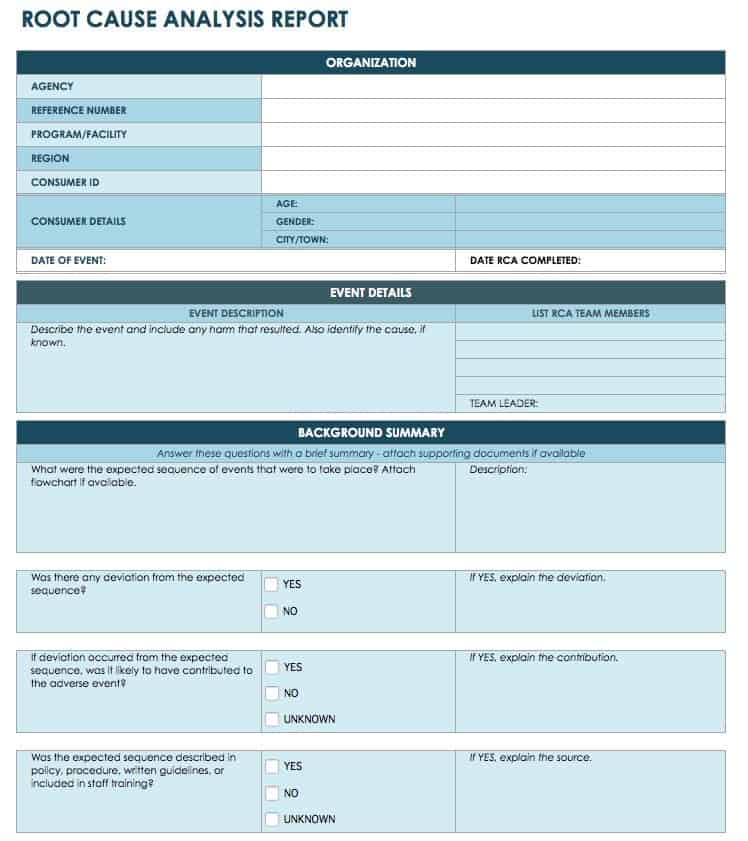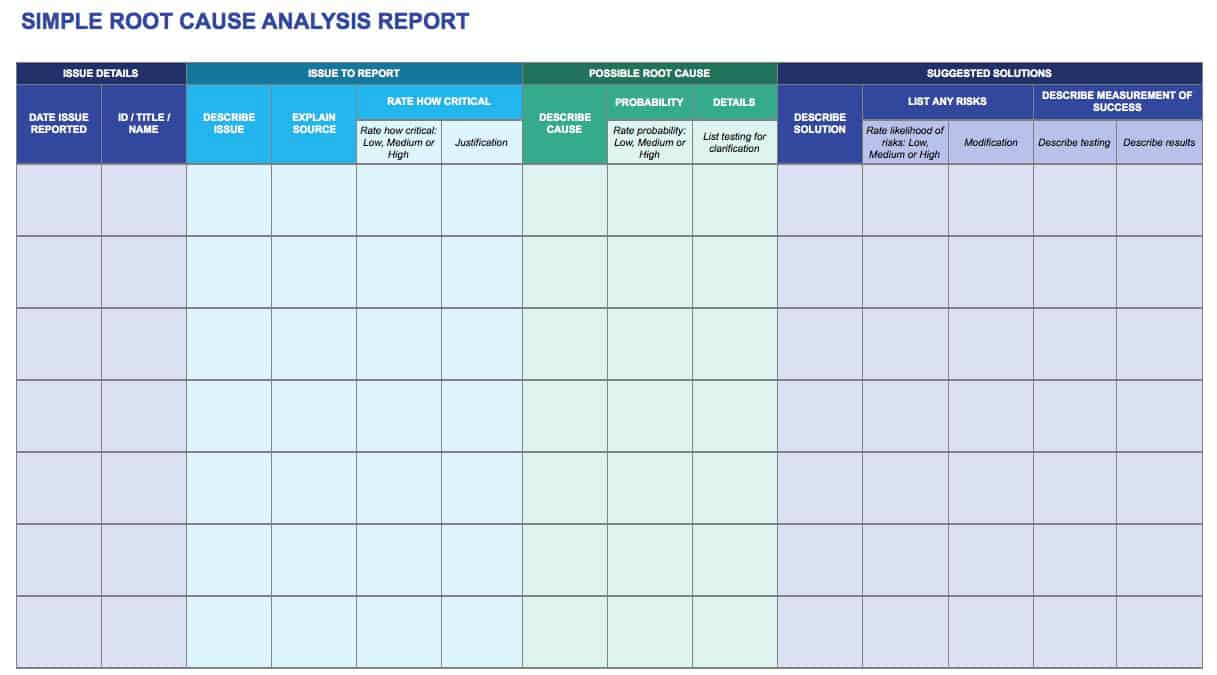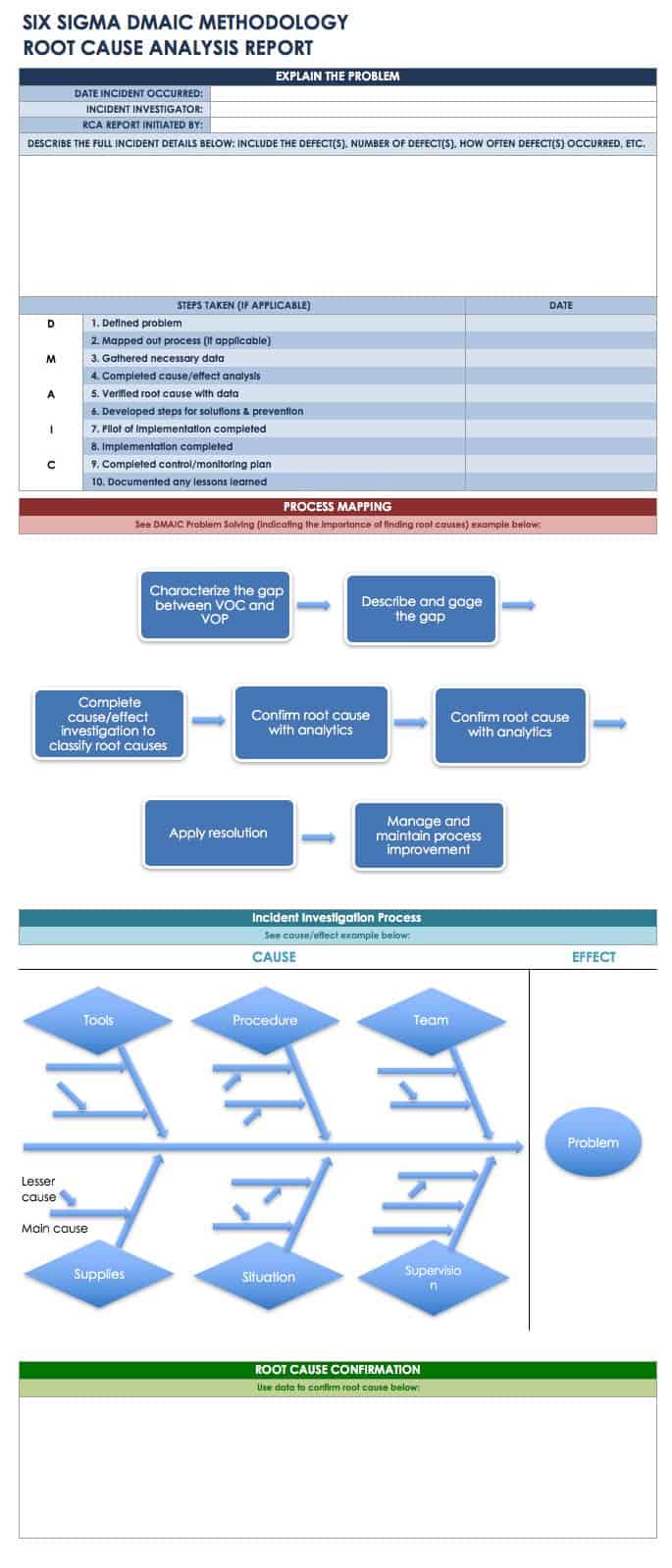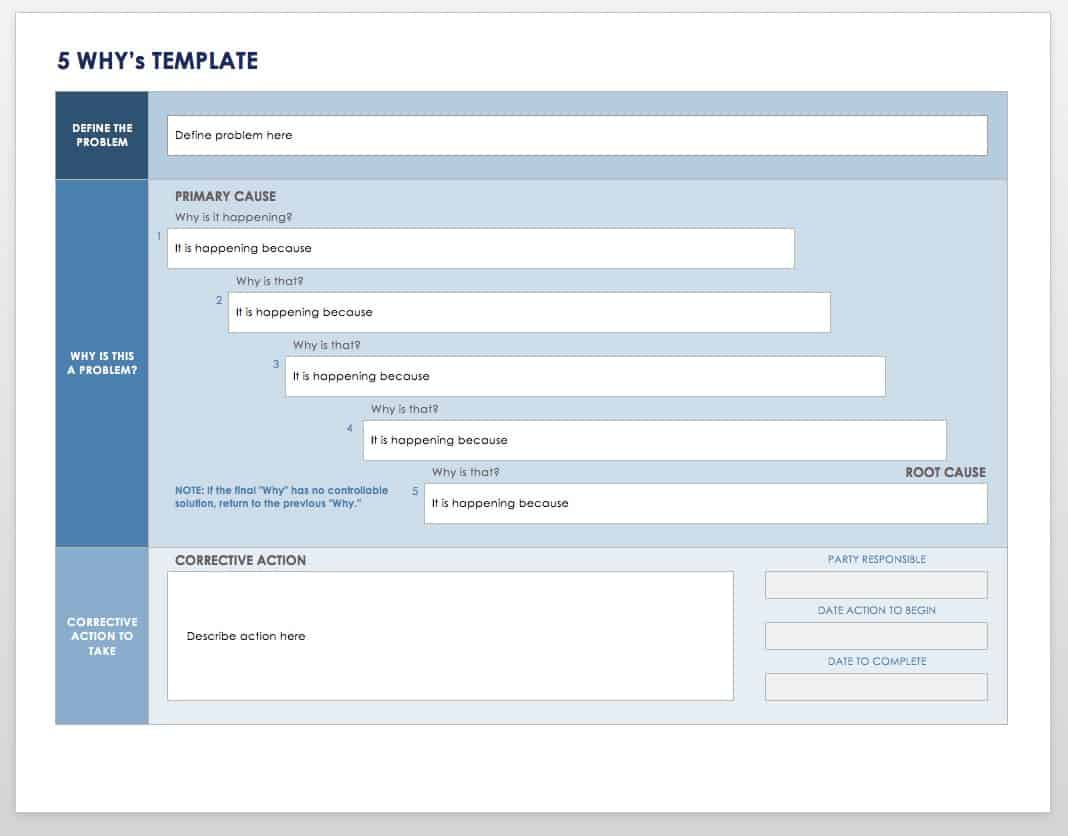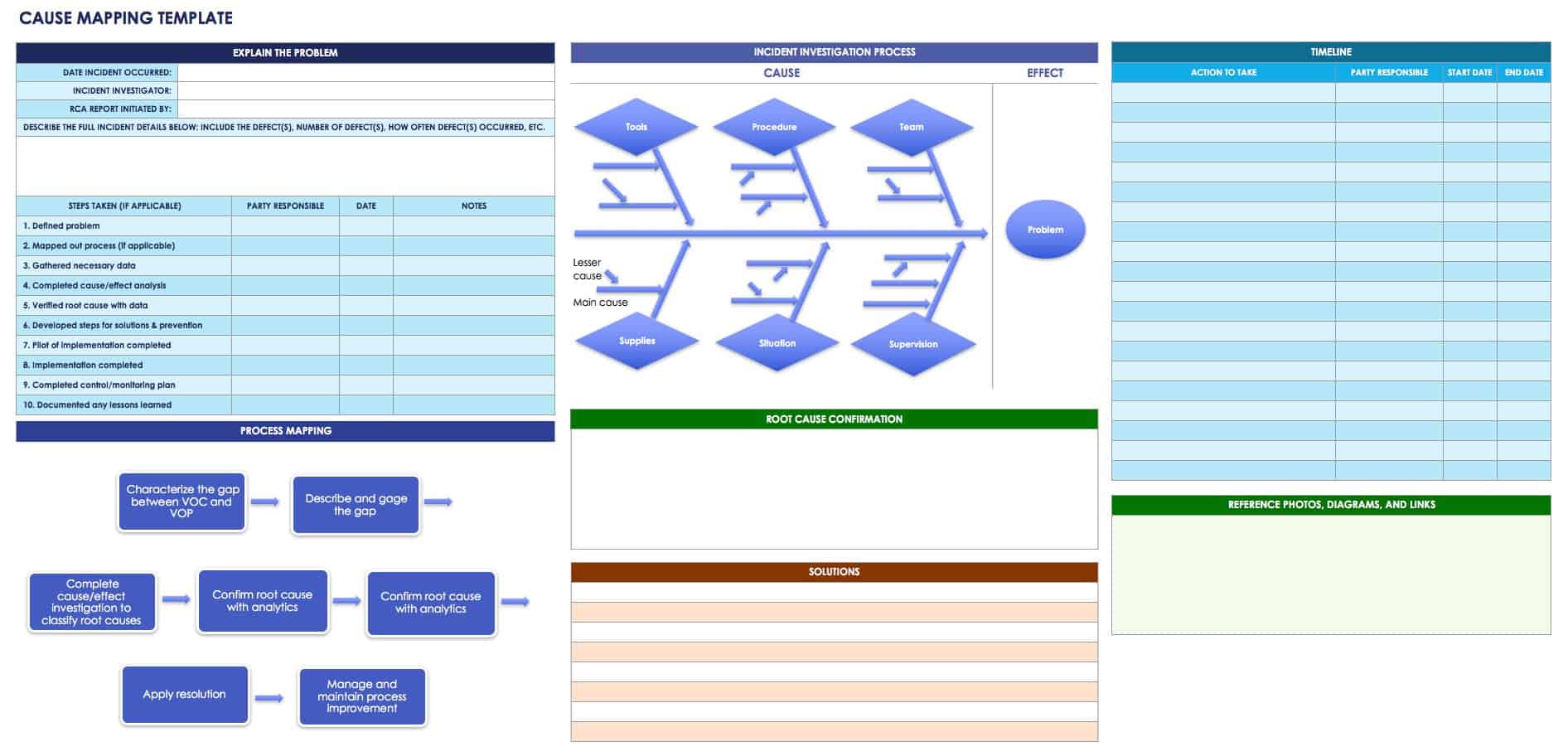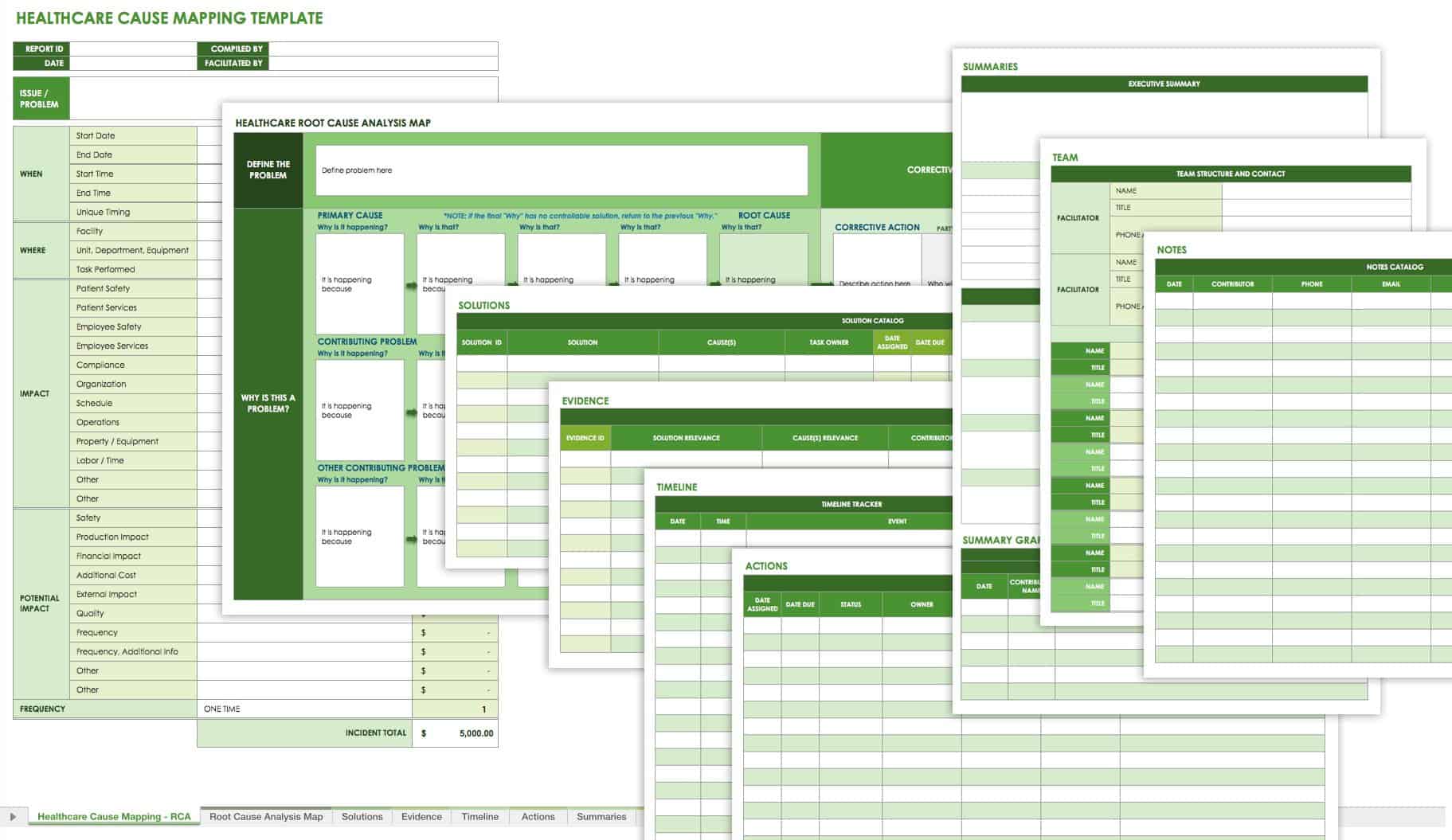Root Cause Analysis Template
Download Root Cause Analysis Template Below
This root cause analysis report template allows for a detailed examination of the event. Use it to record information on the incident’s background and contributing factors, actions taken to reduce future risk, findings related to the identified root cause, as well as other notable findings that aren’t directly related to the problem. It also allows you to record a description of the event itself, the timeline, the investigative team, and the methods used.
Simple Root Cause Analysis Template
Download Simple Root Cause Analysis Template Below
This is a more stripped-down version of the root cause analysis template above. Use this template to examine simpler issues that don’t require detailed analysis. It allows you to record a short explanation of the issue or problem, list potential root causes and possible solutions, and report whether or not those solutions were successful.
Six Sigma DMAIC Methodology Root Cause Analysis Template
Download Six Sigma DMAIC Methodology Root Cause Analysis Template Below
Six Sigma DMAIC is a methodology used to reduce errors and improve business processes. It prescribes its own approach to analyzing and investigating root causes. The “DMAIC” acronym refers to the steps involved in this process, which are similar to the steps described in the introduction:
- Define and Measure: What was expected to happen, and what was the problem that occurred instead? What happened, and when and where did it take place? What is the problem’s significance, and who was impacted?
- Analyze: What are the cause-and-effect relationships between the factors contributing to the problem? Why did the problem occur, and what must be done to keep it from recurring?
- Implement and Control: What are potential solutions to the problem, and what are the causes and benefits of implementing them? How can solutions be monitored and controlled so the problem doesn’t occur again?
This root cause analysis template walks you through each of the steps above, and allows you to enter information about the root cause action plan, resolution, and investigative team. What’s more, this root cause template includes diagrams that can be used to visualize how different contributing factors (e.g., people, processes, and equipment) relate to one another, as well as to the problem itself.
‘5 Whys’ Root Cause Analysis Template
Download ‘5 Whys’ Root Cause Analysis Template Below
Excel | Word | PDF | Smartsheet
A 5 Why root cause analysis template is used to conduct a particular type of root cause investigation. When examining a problem or accident, “why” questions frequently arise (e.g., Why didn’t we address this issue sooner?). The “5 Why” process involves asking a series of these questions—first asking why the incident occurred, then asking why those sub-causes occurred, until the root cause of the issue is eventually uncovered. This template provides a framework for asking “why” questions and determining the root cause. You can also note corrective actions that will be taken to prevent the problem from recurring.
Cause Mapping Template
Download Cause Mapping Template Below
This cause mapping template combines elements of the root cause analysis template, the Six Sigma DMAIC template, and the 5 Whys root cause analysis template. It includes a detailed problem outline, a timeline, a “why” question analysis, diagrams to help illustrate the process, sections for proposing and evaluating possible solutions, and a section for creating an action plan.
Healthcare Cause Mapping Template
Download Healthcare Cause Mapping Template Below
This type of root cause template is formatted the same way as the generic cause mapping template, but is specifically tailored for healthcare organizations. Like the above template, it offers a “why” analysis and supplementary diagrams in addition to the standard elements. However, it also helps you examine how patient safety and services goals have been impacted by your analysis of the problem.
Root Cause Analysis Report Example: Explosion at Acme Chemical Company
Download Root Cause Analysis Report Example: Explosion at Acme Chemical Company
When filling out your own template, use this completed report as an example. This sample root cause analysis examines an explosion at Acme Chemical Company. It describes the incident background, contributing factors, who was involved, what root cause was identified, the risk reduction actions taken, prevention strategies, and incidental findings. Refer to this sample if you need guidance when completing your own root cause analysis.
What’s Included in a Root Cause Analysis
A root cause analysis template, also known as a root cause corrective action template, typically contains the following information:
Event description: The problem or accident being investigated is described in as much detail as possible. This includes the date and time of the event, what happened, who uncovered the problem, and who was impacted by the problem (as well as how they were affected).
- Timeline: This section includes a thorough description of all events before, during, and after the problem or accident occurred. This can help uncover potential underlying causes of the incident. Dates, times, and names of all parties involved are included here.
- Investigative Team/Method: This section identifies the team that will be responsible for investigating the problem, what methods they will use for collecting and analyzing data, and how their findings will be reported.
- Findings/Root Cause: The investigative team reports their findings and describes the root cause they have identified.
- Corrective Action: The action(s) that must be taken to correct the problem—and ensure it doesn’t happen again—are written here. These actions can result in project scope, schedule, and budget changes.
Discover a Better Way to Manage Finance Operations
Empower your people to go above and beyond with a flexible platform designed to match the needs of your team — and adapt as those needs change.
The Smartsheet platform makes it easy to plan, capture, manage, and report on work from anywhere, helping your team be more effective and get more done. Report on key metrics and get real-time visibility into work as it happens with roll-up reports, dashboards, and automated workflows built to keep your team connected and informed.
When teams have clarity into the work getting done, there’s no telling how much more they can accomplish in the same amount of time. Try Smartsheet for free, today.
